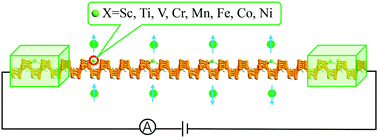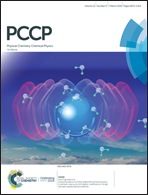Surface engineering of phosphorene nanoribbons by transition metal heteroatoms for spintronics†
Abstract
Modulating the electronic and magnetic properties of phosphorene is important for fabricating multi-functional electronic and spintronic devices. Employing density functional theory combined with the non-equilibrium Green's function, we systematically investigate the electronic, magnetic and transport properties of hydrogenated armchair phosphorene nanoribbons chemically modified by 3d transition metal atoms (Sc, Ti, V, Cr, Mn, Fe, Co and Ni). With chemical adsorption of transition metal atoms, the phosphorene nanoribbons exhibit excellent spin-polarized transport properties. A giant magnetoresistance effect is found with Ti, Fe and Mn adsorption, in which ratios higher than 102 for the Ti and Mn cases, and 105 for the Fe case, are exhibited. Moreover, in the bias range of (−0.2 V, 0.2 V), the Ti, V, Mn and Fe-adsorbed nanoribbons with parallel spin configurations demonstrate a remarkable bias-independent spin filtering efficiency at about 100%, while the Fe and Mn-adsorbed nanoribbons with antiparallel spin configuration show a dual spin filtering effect. The spin-polarized electronic transport properties are closely related to the band structures. Remarkable spin-polarization of the current occurs when the dispersed and flat bands near the Fermi level originate from different spin orientations. The magnetic moments of transition metal adatoms on nanoribbons are reduced by 0.2–2 μB relative to the isolated atoms due to electron rearrangement and charge transfer, which results in various degrees of spin polarization. These results provide a fundamental understanding of the electronic, magnetic and transport properties of transition metal modified hydrogenated armchair phosphorene nanoribbons, and suggest a referential approach to manufacture spintronic devices based on phosphorene.

- This article is part of the themed collection: 2019 PCCP HOT Articles


 Please wait while we load your content...
Please wait while we load your content...